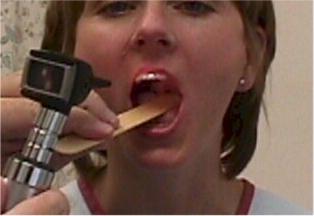|
Examining the Mouth
Function
In the mouth the TEETH mechanically break up food into small particles before
it is swallowed. The salivary glands-parotid, submaxillary, and sublingual-secrete saliva,
which moistens the food, makes it easier to chew, and lubricates the food mass to aid in
swallowing. About 1,500 ml of saliva are secreted daily. Saliva contains one principal
enzyme, ptyalin, which initiates chemical digestion of starches, breaking them into the
complex sugar maltose.
The TONGUE is a muscular organ attached to the lower jaw at the back of the
mouth and is the chief organ of taste. It assists in mastication, swallowing, and speech.
PHARYNX
The pharynx (see The Respiratory System) is the passageway between the mouth
and the esophagus and is shared with the respiratory tract. The EPIGLOTTIS is a
cartilaginous flap that closes the opening to the larynx when food is being swallowed down
the pharynx. Food is deflected away from the trachea to prevent particle aspiration.
Exam
The patient must open mouth widely. With a good light and tongue blade inspect the
inner cheeks (Buccal mucosa) for color, ulcers, white patches.
Teeth — check for:
 Gums — check for: Gums — check for:
-
Iinfection
-
Inflammation
-
Swelling
-
Bleeding.
Tongue — look at the top, bottom and sides.
Throat (Pharynx) — With mouth open:
-
Ask patient to say "ah" if you can not see the pharynx use a tongue blade.
-
Ask for an "ah" and note the rise of the soft palate ( a test for the 10th, Vagus cranial nerve).
-
Inspect the soft palate, anterior and posterior pillars, uvula, tonsils and posterior pharynx.
-
Note any evidence of exudate, swelling, ulceration or tonsillar enlargement.
-
White patches of exudate associated with redness and swelling suggest acute exudative pharyngitis
(strep).
For further information, read:
Otorhinolaryngology,
in The SeaBee Operational Medical and Dental Guide
Aviation
Ear Nose and Throat Medicine, in Operational Settings
ENT in Hospital Corpsman
Sickcall Screeners Handbook
|



